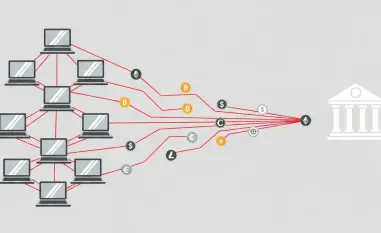In the modern digital environment, cyber threats are akin to natural enemies for businesses. They are dynamic, evolving, and adapting to bypass defenses. Businesses must arm themselves with advanced tools and strategies to withstand these threats effectively, as the cost of staying behind can lead to significant damages. The article advocates for a proactive stance on cybersecurity, focusing on prevention rather than cure.
The Proactive Approach to Cybersecurity
Embracing Prevention Over Cure
In the face of ever-evolving cyber threats, businesses must adopt a proactive approach to cybersecurity. Waiting to react to breaches is not only risky but also inadequate in the current cyber landscape. By implementing advanced tools and strategies, companies can stay ahead of potential threats and protect their critical assets. Embracing a prevention-first mindset involves investing in robust security infrastructures and anticipating cyber attackers’ tactics, enhancing an organization’s ability to thwart potential breaches before they happen.
The focus on prevention also helps organizations avoid the costly aftermath of cyber incidents. Remediation is not only expensive but can also damage a company’s reputation and customer trust. Businesses that adopt preventative measures are better positioned to secure sensitive data, maintain operational stability, and foster a secure environment conducive to growth and innovation.
Continuous Monitoring and Adaptation
Cyber threats are not static; they continuously evolve to bypass existing defenses. As such, businesses need to engage in continuous monitoring and adaptation of their cybersecurity measures to remain effective. This involves staying updated with the latest threat intelligence and adjusting defenses accordingly, ensuring that the security protocols are not outdated. Continuous monitoring allows security teams to detect anomalies in real-time and respond swiftly to mitigate risks, reducing the window of opportunity for attackers.
Adaptation is equally crucial because as threats evolve, so must the defensive tactics. Cybersecurity is an ongoing process, and businesses need to be agile in enhancing their protective measures. This includes regular updates to software, employing the latest security technologies, and training staff on emerging threats and best practices for cybersecurity.
Importance of Threat Intelligence
Equipping Security Teams with Essential Data
Threat intelligence is a cornerstone of a robust cybersecurity framework. It provides security teams with essential data on new and emerging threats, aiding in the analysis of attacks, prediction, and prevention of their development, and profiling of adversaries. This continuous process offers actionable insights to strengthen defenses and avoid operational disruptions, financial losses, data breaches, and reputation damage. Armed with detailed and relevant threat information, security professionals can make informed decisions and stay steps ahead of cybercriminals.
The value of threat intelligence lies in its ability to transform raw data into strategic insights that enhance a company’s overall security posture. By understanding the tactics, techniques, and procedures (TTPs) of threat actors, security teams can proactively create defense mechanisms tailored to counter specific threats. This level of preparedness is critical in averting potential cyber incidents before they escalate into crises.
Enhancing Decision-Making and Resource Allocation
With comprehensive threat intelligence, businesses can make informed decisions about resource allocation and risk mitigation. Understanding the nature and scope of potential threats enables companies to prioritize their cybersecurity efforts and invest in the most effective measures to protect their assets. Proper threat intelligence helps organizations identify high-risk areas, ensuring that resources are directed where they are most needed, optimizing both budget and effort.
Enhanced decision-making capabilities also lead to better strategic planning in cybersecurity. Businesses can develop more effective incident response plans, conduct targeted security training for staff, and implement technological solutions that offer the best return on investment. By basing decisions on data-driven insights, organizations are more resilient against cyber threats and can maintain trust with stakeholders by demonstrating a robust and proactive security posture.
Alignment with Business Objectives
Protecting Critical Assets
Enterprises hold vast amounts of sensitive data, including intellectual property (IP), customer data, financial information, and operational systems. These assets are often targeted by hackers who exploit system vulnerabilities, leading to data breaches, IP theft, or service interruptions. Protecting these critical assets is essential for maintaining core business operations and competitive advantage. Integrating threat intelligence into security practices enables businesses to identify vulnerabilities and reinforce defenses around their most valuable resources.
Proactive measures also ensure the integrity and confidentiality of sensitive data, safeguarding it from unauthorized access and potential exfiltration. By defending critical assets effectively, businesses can preserve their competitive edge, prevent financial losses, and uphold regulatory compliance, which is increasingly important in today’s data-driven economy.
Maintaining Business Continuity
Uninterrupted service delivery and operational stability are crucial for any business to thrive. Cyber threats can disrupt these aspects, leading to significant financial and reputational damage. By aligning threat intelligence with business objectives, companies can ensure continuous operations and minimize the impact of potential cyber incidents. This alignment involves integrating threat intelligence into business continuity planning, which helps devise effective recovery strategies and minimize downtime.
Maintaining business continuity through advanced threat intelligence means having the foresight to anticipate and mitigate risks before they materialize. This proactive stance not only secures operations but also assures customers and partners of the business’s resilience and reliability. Effective continuity management backed by robust threat intelligence fortifies an organization’s reputation and ensures sustained productivity.
Preserving Customer Trust
A breach involving sensitive customer data can decimate brand reputation and invite legal liabilities. By proactively addressing cyber threats, businesses can preserve customer trust and maintain their reputation in the market. This is particularly important in industries where data protection and security are paramount, such as finance, healthcare, and retail. Demonstrating commitment to safeguarding customer information builds confidence and loyalty, which are critical for long-term success.
Fostering customer trust through diligent cybersecurity practices also differentiates a business in a crowded marketplace. It signals to clients that their data privacy is a top priority, thereby enhancing the company’s competitive standing. Moreover, compliance with data protection laws and regulations further solidifies trust, as customers can be assured that their personal information is handled with utmost care and responsibility.
Managing Financial Risk
Cyber threats such as ransomware can demand hefty payouts, while breaches incur costs for remediation, legal fees, and potential lawsuits. Threat intelligence allows for cost-effective preemptive measures, helping businesses manage financial risks associated with cyber incidents. By investing in threat intelligence tools and services, companies can detect threats early, implement effective countermeasures, and avoid the high costs of a full-blown security breach.
Effective financial risk management through threat intelligence also means reducing the likelihood of fines and penalties associated with non-compliance to data protection regulations. With a clearer understanding of the threat landscape and potential financial repercussions, businesses can allocate resources more efficiently, making cybersecurity investments that deliver substantial returns by preventing costly incidents.
Supporting Strategic Growth
Embracing digital transformation and new technologies can be a double-edged sword. Without adequate security measures, innovation can lead to new vulnerabilities. Monitoring emerging threats ensures that growth strategies are secure. Demonstrating robust cybersecurity practices can also position a company as a reliable partner, serving as a differentiator in industries where data protection and security are paramount.
By integrating cybersecurity into their growth strategies, businesses can confidently explore new markets, adopt cutting-edge technologies, and forge strong partnerships. This proactive approach enhances business agility and resilience, enabling organizations to capitalize on opportunities without compromising security. It also signals to potential clients and partners that the company is forward-thinking and prepared to protect jointly managed data and technological initiatives.
Sources of Threat Intelligence
Internal Sources
Effective threat intelligence relies on data from both internal and external sources. Internal sources include elements within the security infrastructure, such as firewalls, endpoint protection systems, and Security Information and Event Management (SIEM) systems. These sources provide valuable insights into potential threats and vulnerabilities within the organization, offering a comprehensive view of the organization’s security landscape.
Collecting and analyzing data from internal sources allows security teams to detect anomalies and patterns indicative of malicious activity. This helps in creating a more nuanced understanding of the organization’s threat environment, fine-tuning defenses, and ensuring that internal and external intelligence seamlessly integrate into a cohesive security strategy. Internal sources are crucial for identifying insider threats and ensuring that internal policies and protocols are adhered to.
External Sources
External sources encompass threat databases, feeds, dark web, open web forums, blogs, and discussions. These sources offer a broader perspective on emerging threats and help businesses stay informed about the latest developments in the cyber threat landscape. External intelligence provides insights into global trends and malicious activity patterns that could eventually affect the organization.
The advantage of external sources is their ability to offer insights into new and emerging threats that have not yet been detected internally. This allows businesses to anticipate and prepare for potential attacks. Using a combination of both internal and external sources provides a holistic approach to threat intelligence, ensuring that companies have a comprehensive and current understanding of the cyber threat landscape.
Third-Party Intelligence Services
Third-party intelligence services, like ANY.RUN’s Threat Intelligence (TI) Lookup, are critical for comprehensive threat intelligence. These services offer tools that security professionals can use to discover and explore pertinent data. They support search operators and their combinations, have teamwork features, and generate comprehensible reports. Utilizing third-party services can enhance an organization’s capabilities, providing access to advanced analysis tools and expert insights.
Utilizing third-party intelligence allows businesses to leverage specialized expertise and access vast datasets without the need to develop these capabilities in-house. Partnering with reputable threat intelligence service providers ensures that businesses receive high-quality data and insights, enabling them to maintain robust defenses against sophisticated cyber threats.
The Need for Real-Time Updates
Staying Ahead of Adversaries
The threat landscape evolves swiftly, with adversaries staying steps ahead. Hence, businesses need up-to-date information to maintain effective defenses. Providers of security solutions must offer automated update tracking features, ensuring businesses stay abreast of the latest threats. Continuous updates from reliable threat intelligence sources help security teams respond promptly to emerging threats, reducing the window of vulnerability.
Staying ahead of adversaries requires a dynamic approach to threat intelligence, where real-time data feeds and automated alert systems play a critical role. Businesses must ensure that their cybersecurity solutions are configured to receive and act upon the latest threat intelligence, thereby fortifying defenses with current threat data and mitigating risks before they can impact operations.
Real-Time Threat Updates
ANY.RUN’s TI Lookup provides live threat updates, which are crucial for maintaining up-to-date defenses. By receiving timely alerts on relevant threats, businesses can continuously monitor and adjust their cybersecurity measures to stay ahead of potential risks. Real-time threat updates enable organizations to pivot quickly, adapting their defensive strategies to counteract new and evolving threats effectively.
Real-time updates ensure that security teams are always equipped with the latest intelligence, enabling rapid decision-making and response. This capability is essential for mitigating the impact of cyber incidents, ensuring that potential threats are addressed before they can escalate into significant breaches. By maintaining current threat data, businesses can implement preventative measures and enhance overall security efficacy.
Overview of ANY.RUN’s Threat Intelligence Lookup
Advanced Tool for Real-Time Insights
ANY.RUN’s TI Lookup is an advanced tool providing real-time, actionable insights into current cyber threats. With a user-friendly interface designed for efficient threat investigations, TI Lookup aggregates and analyzes threat data from public sandbox analyses performed in ANY.RUN’s Interactive Sandbox. This tool is essential for businesses seeking to enhance their threat intelligence capabilities and stay ahead of emerging cyber threats.
The efficiency and comprehensiveness of TI Lookup make it a valuable asset for security teams. By providing detailed analyses of recent threats and offering the ability to conduct granular searches, TI Lookup allows businesses to gain a deep understanding of the threat landscape. This enables targeted responses to specific threats and enhances the overall resilience of the organization’s cybersecurity framework.
Key Features of TI Lookup
Key features of TI Lookup include access to a database containing 40+ types of threat data, covering system events, indicators of compromise (IOCs), behavioral indicators (IOBs), and attack indicators (IOAs). This extensive database ensures that security teams have access to a wide range of relevant and timely threat information. The tool’s capability to provide fresh results from the past 180 days, collected from thousands of sandbox sessions, ensures that the intelligence is current and actionable.
One of the standout attributes of TI Lookup is its fast search functionality, delivering results in just five seconds. This rapid response capability is critical for security teams needing to act quickly on threat intelligence. Additionally, real-time updates provide timely alerts on relevant threats, enabling continuous monitoring and proactive adjustments to cybersecurity measures.
Conclusion
In today’s digital landscape, cyber threats represent formidable adversaries for businesses. These threats are constantly changing, becoming more sophisticated to evade detection and defense mechanisms. To effectively combat these threats, companies need to equip themselves with cutting-edge tools and robust strategies. If they fail to do so, the repercussions could be severe, leading to substantial financial and reputational damages. The essence of the article is a strong recommendation for businesses to adopt a proactive cybersecurity approach. Instead of waiting to react to breaches, organizations should focus on preventive measures. This includes implementing advanced security protocols, conducting regular risk assessments, and keeping up-to-date with the latest cybersecurity developments. By being proactive rather than reactive, businesses can mitigate potential threats before they inflict harm, ensuring a more secure digital environment. In essence, vigilance and forward-thinking are crucial in defending against the ever-evolving landscape of cyber threats.













